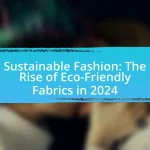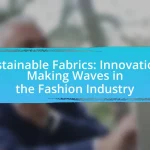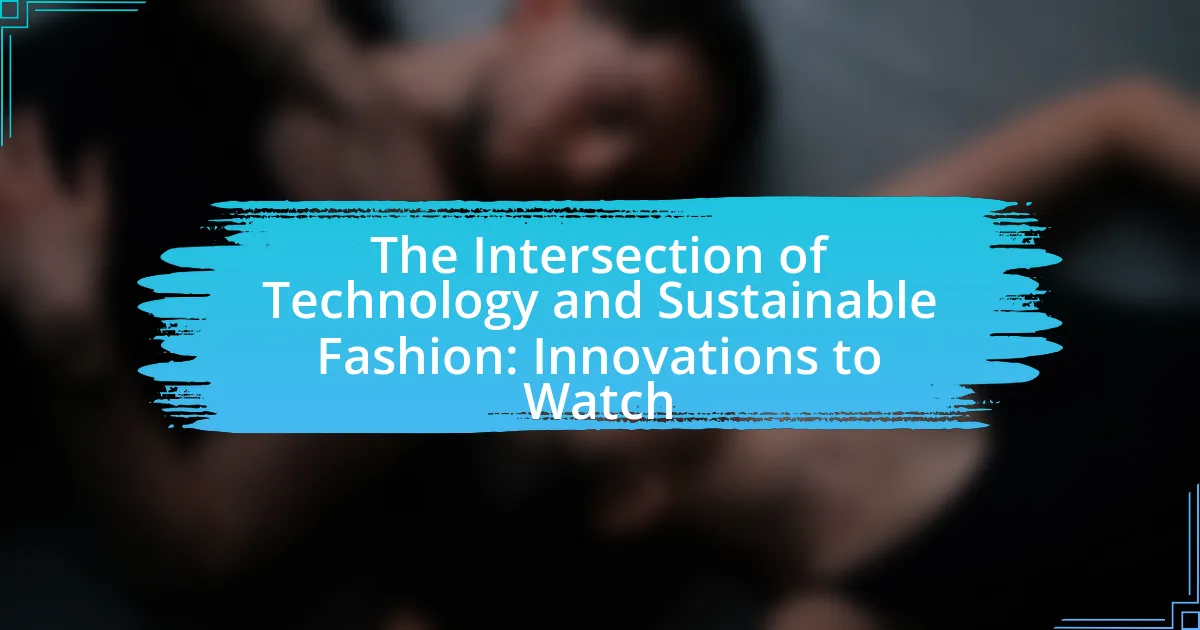Building a sustainable fashion brand from scratch involves creating a clothing line that emphasizes environmental and social responsibility throughout its lifecycle. Key principles include ethical production, resource efficiency, and circularity, which collectively aim to reduce the fashion industry’s significant environmental impact. The article outlines the initial steps for launching such a brand, including market research, defining brand values, and sourcing sustainable materials. It also addresses challenges like sourcing eco-friendly materials and consumer perceptions, while providing strategies for effective marketing, community engagement, and measuring sustainability performance. Additionally, it highlights the importance of transparency and ethical sourcing in establishing a credible brand identity within the sustainable fashion sector.

What does it mean to build a sustainable fashion brand from scratch?
Building a sustainable fashion brand from scratch means creating a clothing line that prioritizes environmental and social responsibility throughout its entire lifecycle. This involves sourcing eco-friendly materials, implementing ethical labor practices, and minimizing waste during production. For instance, brands like Patagonia have successfully integrated sustainability into their business model by using recycled materials and promoting fair labor conditions, demonstrating that it is possible to achieve profitability while adhering to sustainable practices.
How is sustainability defined in the fashion industry?
Sustainability in the fashion industry is defined as the practice of creating clothing and accessories in a way that minimizes environmental impact and promotes social responsibility. This includes using eco-friendly materials, reducing waste through recycling and upcycling, and ensuring fair labor practices throughout the supply chain. According to the Global Fashion Agenda’s 2021 report, the fashion industry is responsible for 10% of global carbon emissions, highlighting the urgent need for sustainable practices to mitigate climate change and promote ethical production.
What are the key principles of sustainable fashion?
The key principles of sustainable fashion include ethical production, resource efficiency, and circularity. Ethical production emphasizes fair labor practices and humane working conditions, ensuring that workers are treated with respect and compensated fairly. Resource efficiency focuses on minimizing waste and utilizing sustainable materials, such as organic cotton or recycled fabrics, to reduce environmental impact. Circularity promotes the idea of designing products for longevity and recyclability, encouraging consumers to recycle or upcycle garments rather than discarding them. These principles collectively aim to create a fashion industry that is environmentally responsible and socially equitable.
Why is sustainability important for the fashion industry?
Sustainability is crucial for the fashion industry because it addresses environmental degradation and social inequality caused by traditional manufacturing practices. The fashion industry is one of the largest polluters globally, contributing to 10% of annual carbon emissions and generating significant waste, with over 92 million tons of textile waste produced each year. By adopting sustainable practices, brands can reduce their ecological footprint, promote ethical labor practices, and foster a circular economy, which is essential for long-term viability and consumer trust.
What are the initial steps to start a sustainable fashion brand?
To start a sustainable fashion brand, the initial steps include conducting thorough market research, defining your brand’s mission and values, sourcing sustainable materials, and creating a business plan. Market research helps identify consumer demand for sustainable products and competitors in the space. Defining your brand’s mission and values ensures alignment with sustainability principles, which is crucial for authenticity. Sourcing sustainable materials, such as organic cotton or recycled fabrics, is essential for minimizing environmental impact. Finally, a well-structured business plan outlines your strategy, financial projections, and marketing approach, providing a roadmap for your brand’s development.
How do you identify your target market for a sustainable fashion brand?
To identify your target market for a sustainable fashion brand, conduct thorough market research to understand consumer demographics, preferences, and values related to sustainability. This involves analyzing data from surveys, social media insights, and industry reports that highlight trends in eco-conscious consumer behavior. For instance, a 2021 McKinsey report indicated that 67% of consumers consider sustainability when making a purchase, emphasizing the importance of targeting environmentally aware individuals. Additionally, segment your audience based on factors such as age, income, and lifestyle to tailor your marketing strategies effectively. This targeted approach ensures that your brand resonates with consumers who prioritize sustainable practices in their purchasing decisions.
What factors should be considered when choosing sustainable materials?
When choosing sustainable materials, factors such as environmental impact, resource renewability, and social responsibility must be considered. Environmental impact involves assessing the carbon footprint, water usage, and pollution associated with material production. For instance, organic cotton uses significantly less water and avoids harmful pesticides compared to conventional cotton. Resource renewability refers to whether materials are sourced from renewable resources, such as bamboo or recycled fibers, which reduce reliance on finite resources. Social responsibility includes evaluating labor practices and ensuring fair wages and safe working conditions for workers involved in the supply chain. According to the Global Fashion Agenda’s 2021 report, sustainable practices can lead to a 30% reduction in greenhouse gas emissions in the fashion industry by 2030, highlighting the importance of these factors in material selection.
What challenges might you face when building a sustainable fashion brand?
Building a sustainable fashion brand presents several challenges, including sourcing eco-friendly materials, ensuring ethical labor practices, and navigating consumer perceptions. Sourcing eco-friendly materials can be difficult due to limited availability and higher costs compared to conventional materials. Ethical labor practices require rigorous supply chain transparency, which can be complex and resource-intensive to maintain. Additionally, consumer perceptions often lean towards fast fashion, making it challenging to educate and persuade customers about the value of sustainability. According to a 2021 McKinsey report, 66% of consumers are willing to pay more for sustainable brands, indicating a market opportunity but also highlighting the need for effective communication and marketing strategies to shift consumer behavior.
How can you overcome financial barriers in sustainable fashion?
To overcome financial barriers in sustainable fashion, entrepreneurs can seek alternative funding sources such as grants, crowdfunding, and partnerships with ethical investors. Research indicates that the global sustainable fashion market is projected to reach $8.25 billion by 2023, highlighting the growing interest and potential profitability in this sector. Utilizing platforms like Kickstarter or Indiegogo can help raise capital while engaging a community that values sustainability. Additionally, forming collaborations with established brands can provide financial support and shared resources, making it easier to navigate initial costs.
What are common misconceptions about sustainable fashion brands?
Common misconceptions about sustainable fashion brands include the belief that they are significantly more expensive than conventional brands, that they lack style and variety, and that all sustainable brands are equally eco-friendly. While some sustainable fashion items may have a higher price point due to ethical production practices, many brands offer affordable options. Additionally, sustainable fashion has evolved to include a wide range of styles and designs, appealing to diverse consumer preferences. Furthermore, not all brands labeled as sustainable adhere to the same environmental standards; consumers should research certifications and practices to ensure authenticity.

How can you effectively develop your brand identity?
To effectively develop your brand identity, start by defining your brand’s core values and mission, which will guide all branding efforts. Establishing a clear vision helps differentiate your brand in the sustainable fashion market, where consumers increasingly seek authenticity and ethical practices. Research indicates that brands with a strong identity can increase customer loyalty by up to 60%, as consumers resonate with shared values. Next, create a cohesive visual identity, including a logo, color palette, and typography that reflect your brand’s personality. Consistency across all platforms reinforces recognition and trust. Additionally, engage with your target audience through storytelling that highlights your sustainable practices, as studies show that 70% of consumers prefer brands that communicate their values transparently. Finally, regularly assess and adapt your brand identity based on consumer feedback and market trends to ensure relevance and connection with your audience.
What elements contribute to a strong brand identity in sustainable fashion?
A strong brand identity in sustainable fashion is primarily built on authenticity, transparency, and a commitment to ethical practices. Authenticity ensures that the brand’s values align with its actions, fostering trust among consumers. Transparency involves openly sharing information about sourcing, production processes, and environmental impact, which enhances credibility. A commitment to ethical practices, such as fair labor conditions and sustainable materials, further solidifies the brand’s identity by appealing to socially conscious consumers. According to a 2021 study by McKinsey & Company, 67% of consumers consider sustainability when making purchasing decisions, highlighting the importance of these elements in establishing a strong brand identity in the sustainable fashion sector.
How do you create a compelling brand story?
To create a compelling brand story, define your brand’s core values and mission, then weave them into a narrative that resonates emotionally with your audience. This narrative should highlight the unique aspects of your sustainable fashion brand, such as the ethical sourcing of materials, the craftsmanship involved, and the positive impact on the environment and communities. For instance, brands like Patagonia effectively communicate their commitment to sustainability through storytelling that emphasizes their environmental initiatives and social responsibility, which has helped them build a loyal customer base.
What role does branding play in consumer perception of sustainability?
Branding significantly influences consumer perception of sustainability by shaping how consumers interpret a brand’s commitment to environmental and social responsibility. Effective branding communicates values and practices that resonate with consumers’ growing awareness of sustainability issues. For instance, a study by Nielsen found that 66% of global consumers are willing to pay more for sustainable brands, indicating that strong branding can enhance perceived value and trust in a brand’s sustainability efforts. Furthermore, brands that transparently share their sustainability practices and achievements tend to foster stronger consumer loyalty, as evidenced by research from Cone Communications, which revealed that 87% of consumers will purchase a product because a company advocates for an issue they care about. Thus, branding plays a crucial role in aligning consumer values with sustainable practices, ultimately affecting purchasing decisions.
How can you engage with your audience and build a community?
To engage with your audience and build a community, consistently create valuable content that resonates with their interests and values. This can include sharing insights about sustainable fashion practices, behind-the-scenes looks at your brand, and user-generated content that highlights customer experiences. Engaging directly through social media platforms, hosting live Q&A sessions, and encouraging feedback fosters a sense of belonging. Research indicates that brands that actively engage with their audience see a 20-40% increase in customer loyalty, as reported by the Harvard Business Review.
What strategies can be used for effective marketing of a sustainable fashion brand?
Effective marketing strategies for a sustainable fashion brand include leveraging social media, collaborating with influencers, and emphasizing transparency in sourcing and production. Social media platforms like Instagram and TikTok allow brands to showcase their sustainable practices and engage with eco-conscious consumers directly. Collaborating with influencers who align with sustainability values can amplify brand reach and credibility, as studies show that 49% of consumers depend on influencer recommendations. Transparency in sourcing and production builds trust; brands that disclose their supply chain practices can increase consumer confidence, as 66% of global consumers are willing to pay more for sustainable brands.
How can social media be leveraged to promote sustainability?
Social media can be leveraged to promote sustainability by creating awareness, engaging communities, and sharing impactful content. Platforms like Instagram and Twitter allow brands to showcase sustainable practices, such as eco-friendly materials and ethical production processes, directly to consumers. For instance, a study by the Global Web Index found that 54% of social media users are interested in brands that promote sustainability. By utilizing hashtags, influencers, and user-generated content, brands can amplify their message and encourage consumer participation in sustainability initiatives, fostering a community that values and supports sustainable fashion.

What are the best practices for sustainable production and sourcing?
The best practices for sustainable production and sourcing include using eco-friendly materials, implementing ethical labor practices, minimizing waste, and ensuring transparency in the supply chain. Eco-friendly materials, such as organic cotton or recycled polyester, reduce environmental impact and resource consumption. Ethical labor practices involve fair wages and safe working conditions, which are essential for social sustainability. Minimizing waste can be achieved through techniques like zero-waste pattern making and recycling fabric scraps, which contribute to resource efficiency. Transparency in the supply chain allows consumers to make informed choices and holds brands accountable for their sourcing decisions. These practices are supported by research indicating that sustainable fashion can significantly reduce carbon emissions and resource depletion, making them vital for building a sustainable fashion brand.
How do you ensure ethical sourcing of materials?
To ensure ethical sourcing of materials, a brand must implement a comprehensive supply chain audit that evaluates suppliers based on labor practices, environmental impact, and material origins. This involves verifying that suppliers adhere to fair labor standards, such as those outlined by the International Labour Organization, which promotes safe working conditions and fair wages. Additionally, brands can utilize certifications like Fair Trade or Global Organic Textile Standard (GOTS) to validate the ethical sourcing of materials. By conducting regular assessments and requiring transparency from suppliers, brands can maintain accountability and ensure that their materials are sourced responsibly.
What certifications should you look for in sustainable materials?
Look for certifications such as Global Organic Textile Standard (GOTS), OEKO-TEX Standard 100, and Cradle to Cradle Certified when sourcing sustainable materials. GOTS ensures organic status and environmental criteria throughout the textile supply chain, while OEKO-TEX Standard 100 certifies that textiles are free from harmful substances. Cradle to Cradle Certified evaluates products for safety, circularity, and social fairness, promoting a sustainable lifecycle. These certifications provide assurance that materials meet rigorous sustainability standards, supporting ethical and eco-friendly practices in fashion.
How can you establish relationships with ethical suppliers?
To establish relationships with ethical suppliers, conduct thorough research to identify suppliers who adhere to ethical practices, such as fair labor standards and sustainable sourcing. Engaging in direct communication with potential suppliers allows for the assessment of their values and practices, ensuring alignment with your brand’s ethical standards. Additionally, visiting suppliers’ facilities can provide firsthand insight into their operations and commitment to ethical practices. According to a 2021 report by the Ethical Trading Initiative, companies that prioritize ethical sourcing often experience improved brand loyalty and customer trust, reinforcing the importance of these relationships in building a sustainable fashion brand.
What production methods are considered sustainable?
Sustainable production methods include organic farming, closed-loop systems, and ethical sourcing. Organic farming minimizes chemical use and promotes biodiversity, which is essential for environmental health. Closed-loop systems recycle materials, reducing waste and resource consumption; for instance, brands like Patagonia utilize recycled polyester in their products. Ethical sourcing ensures fair labor practices and supports local communities, enhancing social sustainability. These methods collectively contribute to a more sustainable fashion industry by addressing environmental and social impacts.
How does local production impact sustainability?
Local production significantly enhances sustainability by reducing transportation emissions and supporting local economies. When products are made closer to the point of sale, the carbon footprint associated with shipping is minimized, leading to lower greenhouse gas emissions. For instance, a study by the International Council on Clean Transportation found that local sourcing can reduce transportation-related emissions by up to 80%. Additionally, local production fosters community engagement and economic resilience, as it creates jobs and encourages the use of local materials, further contributing to sustainable practices.
What technologies can enhance sustainable production practices?
Technologies that can enhance sustainable production practices include advanced manufacturing techniques, renewable energy sources, and digital tools for supply chain management. Advanced manufacturing techniques, such as 3D printing and automated cutting, reduce material waste and energy consumption. Renewable energy sources, like solar and wind power, can significantly lower the carbon footprint of production facilities. Digital tools, including blockchain and AI, improve transparency and efficiency in supply chains, enabling brands to track sustainability metrics and optimize resource use. For instance, a study by the Ellen MacArthur Foundation highlights that adopting circular economy practices through technology can reduce waste by up to 80% in the fashion industry.
What are the key metrics for measuring sustainability in your brand?
Key metrics for measuring sustainability in a brand include carbon footprint, water usage, waste management, and supply chain transparency. Carbon footprint quantifies greenhouse gas emissions, providing insight into a brand’s environmental impact; for instance, a study by the Carbon Trust indicates that the fashion industry contributes approximately 10% of global carbon emissions. Water usage metrics assess the volume of water consumed in production processes, with the World Resources Institute noting that the fashion sector is responsible for 20% of global wastewater. Waste management metrics evaluate the amount of waste generated and recycled, highlighting the importance of circular economy practices. Lastly, supply chain transparency metrics track the ethical sourcing of materials and labor practices, which are increasingly demanded by consumers, as evidenced by a 2021 McKinsey report showing that 67% of consumers consider sustainability when making purchasing decisions.
How can you track your environmental impact?
To track your environmental impact, utilize carbon footprint calculators and sustainability assessment tools. These tools analyze your activities, such as energy consumption, waste generation, and resource usage, to quantify your environmental footprint. For example, the Global Footprint Network provides a calculator that estimates personal or organizational ecological footprints based on lifestyle choices and consumption patterns. Additionally, tools like the Higg Index offer a comprehensive framework for brands to assess their environmental performance across various stages of production, helping identify areas for improvement.
What tools are available for assessing sustainability performance?
Tools available for assessing sustainability performance include the Global Reporting Initiative (GRI), the Sustainability Accounting Standards Board (SASB) standards, and Life Cycle Assessment (LCA) methodologies. The GRI provides a comprehensive framework for organizations to report on their sustainability impacts, while SASB offers industry-specific standards that help businesses disclose material sustainability information to investors. LCA methodologies evaluate the environmental impacts of products throughout their life cycle, from raw material extraction to disposal. These tools are widely recognized and utilized in various sectors, including fashion, to measure and improve sustainability performance effectively.
What practical tips can help you succeed in building a sustainable fashion brand?
To succeed in building a sustainable fashion brand, focus on sourcing eco-friendly materials and ensuring ethical production practices. Sustainable materials, such as organic cotton or recycled fabrics, reduce environmental impact and appeal to conscious consumers. Ethical production involves fair labor practices and transparency in the supply chain, which fosters trust and loyalty among customers. According to a 2021 McKinsey report, 67% of consumers consider sustainability when making purchasing decisions, highlighting the importance of these practices in attracting a market that values environmental responsibility.

















